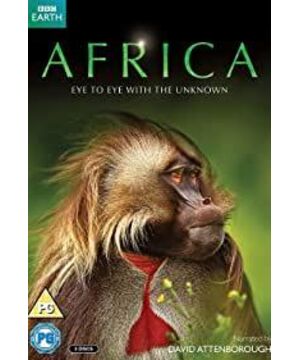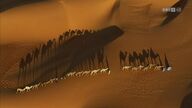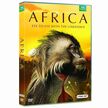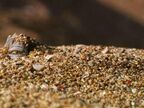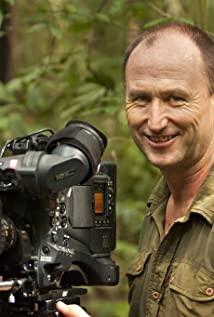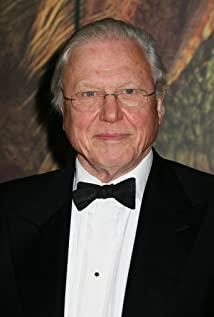For the specificity of the comparison, I deliberately selected the first episode of "Africa"-Kalahari Desert and the sixth episode-(Long Song) Populus euphratica, the two episodes about the desert theme as the same type of analysis.
Truth is the soul of documentaries. In recent years, more documentaries have used storytelling narratives to increase viewing and drama. The BBC has always had its leading originality in this regard. It is vividly reflected in "Africa".
First, start with the way of shooting the protagonist's appearance. When the commentary said, "In winter, the temperature in the morning is lower than usual. The low temperature is a problem for the capuchin swallow. His prey will not appear in the cold winter... He is Ka Lahari’s greatest deceiver", the panoramic picture of the capuchin swallow appears, close-ups in multiple directions show the protagonist’s appearance in detail, and the commentary emphasizes his difficulty—the prey is scarce, and the small mongoose family later Appearance has also appeared in such a dynamic form-from one to two to a group, laying the groundwork for the subsequent struggle between the two. In "Song of the Forest", a long close-up shot is taken to statically enter the painting-"The iguana has never left its own home. In nearly two decades of its life, its world has always been the only Hu Poplar." The protagonist in the foreground and the background environment are clearly explained, and the Populus tree is related to it, which is not competitive, and shows a harmonious and natural relationship with every movement.
Second, the beauty of narrative lies in the creator's grasp of drama. In "Africa", the struggle between the capuchin swallow and the meerkat takes place in a compact and neat twist-the first time: the capuchin swallow calls the police and the mongoose avoids danger, and the second time: the capuchin swallow successfully deceives the food. "Thank you very much~" was added deliberately. The third time: At first, the meerkat knew that he was deceived and ignored the swan. Then he heard the sentry alarm and hurried to retreat, but later found that there was no danger at all. It was the capuchin swallow imitating, and in a moment of surprise, the capuchin swallow succeeded again. At this time, the commentary began: a group of meerkats were defeated by a capuchin swallow, and the ending of the short story was successfully concluded. The fragments of less than five minutes before and after have a moderate degree of succession and transformation, and the drama has brought extremely rich interest. There are also fragments of the rhinos communicating with each other in the moonlight, the rhythm is soft and soothing, and the impact of their "love triangle" has not been lost. When the first male rhinoceros failed, the female rhinoceros left, and the second male rhinoceros succeeded, the intersection under the soft moonlight has a light and beautiful atmosphere, one after another like a romantic love story. Although the narrative of "Song of the Forest" is not so sophisticated, it uses clues to connect the whole film. The most important clue is the black stork-"The black stork skimmed silently across the sky and returned to the Taklimakan Desert from the south..." At this time The scene shows the black storks passing by their shadows from the top of the iguanas, and then when the old man Simayi appeared on the scene, "The old man has lived in the Populus euphratica forest since he was a child, and he knows every inhabitant and passerby here. They extend spring greetings to each other and greet the new together. One year. The one-armed tree on the edge of the oasis guided the black stork to find a home after half a year.” At this time, it is the black stork stepping through the poplar forest, accompanied by a commentary. It has a unique dynamic beauty and a sense of desolation. The last animal shot of the film uses a close-up of a black stork as a response to the next group of black storks, again emphasizing the complete story, and it is accompanied by low and melancholic music to achieve the overall harmony of the atmosphere. There are also small fragments of clues narrative such as the inchworm: "The subtle sprouting on the Populus euphratica torso awakens the small life under the ground. The inchworm has finished ten months of sleep and returned to the Populus euphratica forest from the soil ten centimeters deep under the tree." This is the inchworm. After they hibernate, lay eggs, are dug out by children to play, and then to the scenes of the old people climbing branches while praying, they are all scattered fragments. This is a stretched narrative line, not compact and Intuitive drama is based on interspersed fragments as a narrative.
three. The creation of suspense is also the biggest difference between the two films. "Africa" is based on the idea of the protagonist of the fragment. In the cheetah fragment, a large empty mirror is drawn from the panorama of the little cheetah to emphasize the harsh living environment of the "extremely thirsty land", and then to the environment when the little cheetah goes out hunting. In the scene, the rhythm is tense. The mother almost died because of the big warthog, so he could not catch it. The commentary "He found an easier target-Shi Ling" is a very realistic turning point. Suspense, and when he was disappointed and scared away the prey, "The cheetah had to go home thirsty and hungry." When the mood of watching movies fell to the bottom, he immediately found the prey that his mother left in the tree for him. Hope It rekindled, fell into a trap several times and then created suspense for the audience: Is anyone hunting? This wonderful application of twists and suspense makes the film endless and interesting. Compared with "Song of the Forest", the creation of suspense is too weak, most of which are real pictures of harsh environments, and direct expression of the chest does not leave enough points of interest for the audience.
In the use of the lens, the two films also have their own characteristics. The rhythm of "Africa" is fast, with excitement and shaking like strong wine, fully displaying the instinctive, strong and tenacious driving force of survival and reproduction in Africa. At the beginning of a series of empty shots of big and long-term perspectives, after turning to the host to immerse in the scene and explain the location and characteristics of the place, a vast African spectacle came to mind. "Song of the Forest" uses an electronic analog map to explain the area and species diversity due to its desolate and low style, and uses scientific and technological means to show the general image of the landscape.
In this regard, "Africa" has more intuitive impact of images, and the way of blanking also leaves more space for the audience's imagination. The shots of "Africa" are used in a patchwork manner. In the clip of the love triangle with giraffes, several extremely fierce fighting scenes are statically set off the dynamic fierceness. The slow-motion playback is used to show in detail several slow-motion close-ups and wonderful close-ups of the giraffe expression. The combination of beautiful scenery is very interesting, vivid and charming. In the scene of the battle between the two deer and their forces, the close-up of the crossed necks emphasizes the confrontation and brings an exciting fighting atmosphere. After the old deer's victory, a slow-motion close-up of his hip injury, the image of a martyr is deeply rooted in the hearts of the people. . In "Song of the Forest", the shots are mostly slow empty shots, which match the rhythm of the whole film, like a strong tea that is tasteless but tasteless at first. "Taklimakan has the finest and smallest sand in the world. A little wind can make them dance. In March, as soon as the sun comes out, the warm northeast wind blows up, and the sands begin a new journey. Several partial close-ups and The empty mirrors of several large environments set off a strong sense of desert desolation. When depicting the stalwart banks of the river, “in the center of the Eurasian continent, the Tarim Basin is like a yellow eye. This is the most mobile desert in the world-Taklimakan. The snow water from the surrounding mountains flows to the interior of the basin and converges into the Tarim River system, the source of life in the desert. "The flowing lens and the surrounding vast environment are drawn into the painting, showing the only vitality in the desert.
Everything grows. Nature always has its broad mind, a treasure, waiting for us to explore and cherish.
——Writing because of homework, It's too lazy.
View more about Africa reviews


